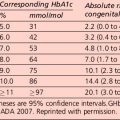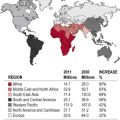Section 2 Initial management and education
Clinical presentation of diabetes
Type 1 diabetes
The clinical presentation of type 1 diabetes in younger patients is usually acute with classical osmotic symptoms (Table 2.1).
Table 2.1 Presenting features of type 1 diabetes
| Osmotic symptoms | Associated symptoms |
|---|---|
| Thirst | Muscular cramps |
| Polyuria | Blurred vision |
| Nocturia Weight loss Fatigue and lassitude | Fungal or bacterial infection, usually orogenital and cutaneous, respectively |
Associated symptoms, particularly blurred vision may occur, although these are generally less prominent. Although the islet β-cell destruction of type 1 diabetes is a process that occurs gradually. It is very uncommon to detect type 1 diabetes during the early asymptomatic stages of the condition. Once symptoms appear, diagnosis may sometimes be expedited by awareness of symptoms in other family members with diabetes. Despite the presence of significant osmotic symptoms, patients sometimes do not seek medical advice and may present in DKA (see Table 1.4).
DKA is a life-threatening medical emergency requiring hospitalization. The diagnosis and management of DKA is considered in more detail in Section 4.
Type 2 diabetes
The presenting clinical features of type 2 diabetes (Table 2.2) range from none at all to those associated with the dramatic and life-threatening hyperglycaemic emergency of the hyperosmolar non-ketotic syndrome. In many patients with lesser degrees of hyperglycaemia, symptoms may go unnoticed or unrecognized for many years; such undiagnosed diabetes carries the risk of insidious tissue damage.
Table 2.2 Presenting features of type 2 diabetes
| None – asymptomatic patients identified by screening |
| Osmotic symptoms |
| Infection |
| Macrovascular complications |
| Microvascular complications |
| Associated conditions |
Patients with diabetes tend to present in four main ways:
• Classical signs and symptoms – osmotic symptoms plus weight loss
• With macrovascular and/or microvascular complications
• Diabetic decompensation – DKA/HONK (hyperosmolar hyperglycaemic state)
• Routine testing at general practitioner (GP) consultations, medical and surgical clinics/insurance medicals.
History and initial physical examination
Having obtained a detailed history, a physical examination should be undertaken (Table 2.3). The consultation should take place in appropriate and comfortable circumstances.
• The mode of diagnosis and presence of symptoms should be recorded.
• Family history of diabetes should be reviewed.
• For women, enquiry into obstetric (stillbirths, large babies, gestational diabetes) and menstrual history (oligomenorrhoea, especially with features of hyperandrogenism) may be relevant.
• Associated conditions (see Section 1), predisposing and aggravating factors should be identified.
• A detailed history of drug use, smoking habits and alcohol consumption is required along with an enquiry into habitual physical activity and sporting interests.
• Height and weight (plus waist circumference) need to be recorded and body mass index calculated.
• Blood pressure should be measured carefully; lying and standing pressures should be recorded if there is any suggestion of postural hypotension arising from autonomic neuropathy. In diabetes there may be a postural drop with few or no symptoms.
• Evidence of established diabetic complications including neuropathy (including autonomic dysfunction where appropriate) should be sought diligently at diagnosis in patients with type 2 diabetes (see Section 5).
• Unless contraindications exist, notably angle-closure glaucoma, the fundi should be examined through pharmacologically dilated pupils in all patients with type 2 diabetes, as well as in patients with features that are not classical of autoimmune type 1 diabetes.
• Features of other endocrinopathies, signs of marked insulin resistance and specific syndromes of diabetes such as the lipodystrophies are rare.
Table 2.3 Components of the comprehensive diabetes evaluation
BMI, body mass index; CHD, coronary heart disease; DKA, diabetic ketoacidosis; DSME, diabetes self-management education; GFR, glomerular filtration rate; HDL, high density lipoprotein; LDL, low density lipoprotein; MNT, medical nutrition therapy; PAD, peripheral arterial disease.
Source: American Diabetes Association (2011). Reproduced with permission.
Nephropathy
Type 2 diabetes
In addition to early nephropathy, the presence of microalbuminuria may reflect a further increase in risk of macrovascular disease (see p. 199). However, because nephropathy can develop during the asymptomatic phase preceding diagnosis, plasma creatinine should be checked, especially if Albustix-positive (indicative of urinary protein losses of 500 mg/day or more; see p. 200).
Neuropathy and foot disease
Evidence of these complications should be evaluated carefully at diagnosis in patients with type 2 diabetes, as detailed in Section 5.
Screening for diabetes
In the UK Prospective Diabetes Study (UKPDS), the severity of diabetes-related tissue damage correlated with the glycated haemoglobin (HbA1c) concentration at diagnosis of type 2 diabetes. Thus, there is the prospect that earlier intervention in patients identified by screening of asymptomatic at-risk individuals may prevent or retard chronic diabetic complications. Type 2 diabetes satisfies some of the major criteria for a disorder for which screening would be appropriate. However, there is little evidence to suggest that population screening is cost effective. It is appropriate to screen ’at risk’ groups (see Section 1).
Initial management
Identification of patients with apparently autoimmune diabetes with a relatively slow onset can be problematic; the prevalence of latent autoimmune diabetes in adults (LADA) is not known but is perhaps under diagnosed (see Section 1). The diagnosis is often made retrospectively (glutamic acid dehydrogenase (GAD) + ve, anti-islet cell + ve) following the rapid failure of treatment with oral antidiabetic agents (see Section 3, p. 97). Useful clinical pointers at diagnosis suggesting that insulin may be required include:
• unintentional weight loss preceding diagnosis
• normal body weight or underweight for height at diagnosis
• presentation with osmotic symptoms of short duration
Stay updated, free articles. Join our Telegram channel

Full access? Get Clinical Tree







